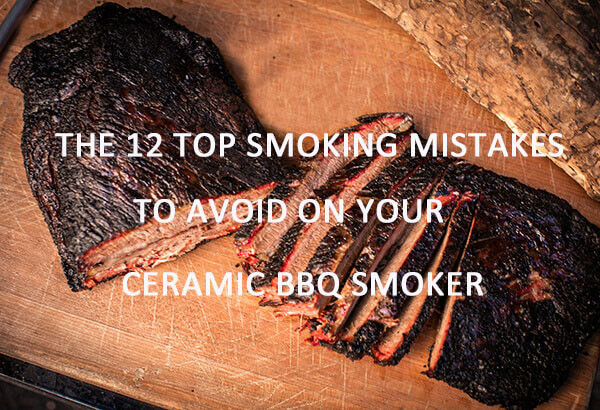Although smoking meat should be enjoyable, when you first begin it may seem overwhelming because there is so much to learn. It can be stressful when your guests start arriving when everything is going wrong. Next thing you know your friends are “out of town” every time you host a barbecue. It’s even more fun with some practice and noticing these common mistakes that almost everyone makes. Here we share some views regarding the 12 top smoking mistakes to avoid on your bbq smoker.
1) Not giving yourself enough time
Not giving yourself enough time is a big mistake that can lead you to start making many other mistakes.
When the clock ticks and guests are coming, you might think it’s a good idea to close the vents to trap more smoke or start adding more coals to the fire.
The tips:
Grilling requires prep time and patience.
You can’t rush it, as every cut of meat is different, so it’s hard to get an accurate estimate of cooking time.
While some argue that if you start cooking in a smoker, you should end up in a smoker, if it gets dark and you’re out of fuel, you can always resort to “Texas cheating.”
This cooking method involves smoking the meat for several hours, then wrapping it in foil, sometimes with the juices, and roasting it in a 325°F (160°C) oven for several hours.
2) Too much smoke
Probably the truest smoking mistake, and the one I get the most emails about.
If a little smoke makes meat taste delicious, a lot of smoke must make it taste delicious, right?
Unfortunately, this logic can lead to some pretty atrocious grilling.
Using too much wood and not understanding fire management is one of the biggest mistakes grilling rookies make.
You can make things worse by closing the vents to accommodate more smoke. It’s a surefire way to get your meat straight into the trash.
The tips:
Smoking is definitely a case of less is more.
You want to see thin lines of smoke coming out of the grill.
The right amount of wood depends largely on the type of grill you are using. On a Weber Smokey Mountain you only want to use a few fist-sized pieces of smokey wood.
A good rule of thumb is to use about two ounces of wood and adjust from there.
Always keep the inlet and exhaust dampers at least slightly open, and be careful how you close the inlet dampers, or the fire may smolder and emit foul-smelling smoke.
If the smoke smells bad, the meat will also taste bad.
3) Overadjusting your grill settings
Imagine this scenario.
You are smoking your first cigarette and everything is going well. You use a charcoal chimney to fine and ash the coals, and you’ve got the cooking area and drip pan set up.
You start imagining what a juicy pork butt would taste like, and then you notice the temperature start to rise.
In a panic, you lift the lid, open the vents, and make frantic adjustments until the temperature drops.
Your thinking is correct, but always completely over the target.
The tips:
You may feel stressed when you see the temperature start to rise, but you shouldn’t panic.
Avoid trying to tweak too many things at once, or you can easily overkill.
Change one thing, see what happens, then change another.
If you smoke a Weber kettle or similar setup, make sure to avoid closing the top and bottom vents completely as this will extinguish the fire.
You should also avoid opening the lid too often. The key to maintaining a steady temperature is to make only small adjustments.
4) Using the wrong cut of meat.
It’s tempting to just grab the cheapest piece of meat in the meat section of your nearest supermarket chain and start smoking.
But if you want to produce great-tasting pulled pork, ribs, or brisket, you have to start with the best quality you can afford.
The tips:
Your local butcher is your best friend. Tell your butcher exactly what you are looking for. This will depend on what you intend to smoke.
This is a huge topic in itself, but some important things to note are:
Ribs – You want to be looking for good meat coverage on the bones and avoid excess surface fat. Avoid buying frozen if you can.
Brisket – Try buying a whole brisket with nice marbling and white hard fat, about 1/4 inch to 1/3 inch (0.6 cm – 0.8 cm) thick across the flat part.
Pork Butt – While a bit more forgiving than brisket, for best results look for the big “money muscle” on the other end of the bone.
“Look at the other end of the bone. It’s tubular (streaked and streaked). You’ll see bands of fat spread evenly over the muscle. When fully cooked, the fat should melt easily and show up.”
5) Use lighter fluid to start the charcoal block.
This is one of the most common grilling mistakes amateurs make. I see! You are impatient and want to start cooking right now.
Before dipping charcoal into lighter fluid, know that this can give off some really bad smells and create weird flavors in bacon.
Not to mention it defeats the whole point of slow cooking!
The tips:
A quality chimney starter is one of the best investments you can make.
Lighter cubes work well, but all you need are a few paper towels.
Put them on the bottom grate of the grill, fill the chimney with coals, then place it on the grill and light the paper towels.
You should see smoke curling up and feel the heat.
Make sure you keep an eye on it, and in 20 minutes you’ll be good to go.
6) Not controlling the temperature inside the grill
Good grilling requires long, steady low heat.
A common mistake is exposing meat to too high a temperature, causing it to dry out and become tough. This can be especially challenging when trying to smoke on a propane grill.
The tips:
It may take a few tries to do this, but you want to try to keep the temperature between 225-250°F (107 – 121°C).
Controlling the temperature of your smoker depends on the type of smoker you use.
You can control the temperature of your charcoal smoker by opening the vents or intake dampers to increase the temperature and closing the vents to reduce oxygen flow and lower the internal temperature.
It is important to allow the smoker to settle before adding meat.
Let it sit on a thermometer away from direct heat for 15 to 20 minutes until the temperature stabilizes before adding your meat.
To keep everything under control you need a good thermometer setup with one probe for the air temperature and another probe for the meat temperature.
Finally, it is important to have a dish full of water in the grill chamber to absorb heat and help regulate the temperature. Water evaporates after prolonged cooking, so check and refill every 3-4 hours.
7) Drinking too much alcohol at the grill
Spending time outdoors with a few sips of a cold beverage is one of the great benefits of smoking.
But don’t be surprised if by the 6th beer your constant supervision starts to relax.
It didn’t take long for the heat to become too high, and 12 hours and 9 pounds of brisket turned into inedible chunks of beef jerky.
If you’re really unlucky, the combination of meat fat, hot fuel, and airflow can lead to an epic grease fire.
If you’re really smart, you might even find yourself the star of a viral video.
The tips:
Maintaining an internal temperature of 225-250°F (107 – 121°C) may require close supervision over extended periods of time.
Go ahead and have a couple of beers, but especially if it’s your first beer, remember to stay focused and maybe drink bourbon after you’ve finished.
8) Panic at stall
Waiting for meat to reach the perfect temperature for grilling can be frustrating if you’re impatient.
If you’ve ever smoked a brisket or pork shoulder, chances are you’ve experienced the dreaded “stall.”
When the temperature on the thermometer decides it doesn’t want to change for hours at a time.
Don’t make the rookie mistake of rushing and adding heat. Remember, the goal is juicy meat, not stew.
The tips:
There are many theories about this stall, from moisture leaving the meat, fat slowing down, or protein breakdown.
9) Open the grill lid frequently to peek.
Once you’ve chosen the right cut of meat, prepped it, and the grill and coals are ready, your excitement levels will be at an all-time high.
However, continuing to open the lid will dissipate heat and the smoker will be below temp.
The tips:
The meat is not going anywhere! Your thermometer should tell you everything you need to make any adjustments.
Open the lid only when you need to mop or spray, move meat, or tend to coals. You don’t need to check it all the time.
The magnitude of this error really depends on what you’re smoking, some peaks should be fine.
10) Trust the dome smoker's thermometer
Hood thermometers will lie to you.
Most grills and smokers will have a “handy” dial mounted on the dome.
They’re almost always cheap, and because they sit near the top of the lid, it registers the temperature of the air space above the food you’re cooking.
The tips:
Ignore the inaccurate built-in smoker.
The best way to monitor your internal temperature is to purchase a digital dual probe thermometer.
This allows you to measure the temperature of the grill and the food at the same time.
11) Choosing the wrong type of wood.
Debating what type of wood to smoke with can cause family and friends to roll their eyes.
There is absolutely no need to match wood “flavor profiles” for different foods. Some even think the whole concept is “wishful thinking.”
That said, it’s important to get the basics right by using the right type of wood.
The tips:
Knowing which woods are best for your smoker, and which ones to avoid is a good first step.
Fruit woods like apple and cherry are always safe bets when it comes to wood types. You can also try oak, hickory and mesquite.
You should avoid any painted or treated wood, as well as pine, fir, cedar, or Cyprus wood.
12) Not treating your finished meat with the respect it deserves
After so many hours of working and waiting, I understand the desire to start slacking off.
But not resting enough or slicing with grains can spoil an otherwise tasty cut of meat.
The tips:
From around 7:10, Aaron Franklin explains how long to let your brisket rest, as well as some good tips for cutting brisket.
The key is to slice along the grain of the meat to achieve the optimum thickness for a No. 2 pencil sirloin slice.
Get the help of the above 12 top smoking mistakes to avoid on your ceramic bbq smoker.
Even the most experienced chef may spot more than one of these mistakes. Get the help of the above 12 top smoking mistakes to avoid on your bbq smoker. Hopefully you’ve learned some things to avoid, but don’t be discouraged if your grill isn’t perfect the first time.

